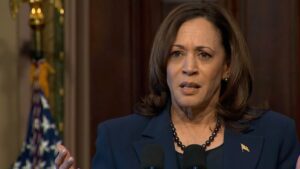In the wake of Rachel Morin’s tragic death—a woman who was brutally beaten, raped, and murdered—Vice President Kamala Harris expressed sympathy but quickly shifted the blame to former President Trump’s border policies. This moment highlights a concerning tendency for Harris’ misleading deflection, and responsibility, and misrepresent the implications of current immigration policies. Instead of acknowledging the failures that led to such heinous crimes, Harris’s attempt to point fingers raises serious questions about her leadership and the Biden-Harris administration’s approach to public safety.

K Harris – CNN 2024
Shifting the Blame
Rachel Morin’s death was devastating, and as more details emerged about her attacker, the implications of weak border security became glaring. Harris, in her typical fashion, expressed remorse but quickly pointed fingers at Trump, blaming his immigration policies for the state of affairs at the border.
This is a dangerous and dishonest deflection. Trump’s policies were built on the principle of deterrence—strengthening the border, implementing the “Remain in Mexico” policy, and pushing for the construction of a border wall. These measures were meant to prevent exactly what happened to Rachel Morin: dangerous criminals slipping through the cracks. Yet, under the Biden-Harris administration, the border crisis has worsened. Illegal crossings have reached record highs, and the administration’s lax approach to enforcement has allowed many dangerous individuals to enter unchecked.
The tragic result? Crimes like the murder of Rachel Morin—preventable, had our leaders taken a tougher stance on border security.
The “Remain in Mexico” Policy: A Missed Opportunity
One of Trump’s most effective border strategies was the “Remain in Mexico” program (officially known as the Migrant Protection Protocols). This policy required asylum seekers to wait in Mexico while their claims were processed in the United States, dramatically reducing the number of unchecked migrants entering the country. It was a strong deterrent for illegal crossings and ensured that only vetted individuals could await legal decisions on U.S. soil.
The Biden-Harris administration, however, terminated this program shortly after taking office. The result has been chaos at the border, with overwhelmed immigration authorities and a surge of unvetted migrants flooding into the country. This policy reversal has opened the floodgates to criminals entering the U.S., contributing to tragedies like the one that took Rachel Morin’s life.
Had the “Remain in Mexico” policy been left in place, it’s possible that Rachel Morin’s attacker would never have been able to enter the United States. This is a direct failure of the Biden-Harris administration’s border policies, and Harris’s attempt to blame Trump for this tragic crime rings hollow.
The Facts on Border Security
Trump’s border policies were not without controversy, but they were effective in controlling illegal immigration. His administration reduced illegal crossings to their lowest levels in years through a combination of physical barriers and agreements with Mexico to manage asylum seekers. The “Remain in Mexico” policy, for example, required migrants to stay in Mexico while their asylum claims were processed, reducing the flow of unchecked individuals into the United States.
These policies were working—until the Biden-Harris administration came into power and systematically dismantled them. They promised a more “humane” approach to immigration, but the reality has been a humanitarian and security disaster. With record numbers of migrants flooding across the border, law enforcement is overwhelmed, and the process of vetting individuals has broken down. This has allowed criminals to enter the country, resulting in tragedies like the murder of Rachel Morin.
Harris’s Tough-on-Crime Stance: Gangs, Cartels, Drugs, and Missing Children
Harris has tried to portray herself as tough on crime, especially when it comes to combating gangs and drug cartels. However, her administration’s policies do not align with this narrative. The rise in illegal immigration has enabled criminal organizations to expand their operations, trafficking drugs and contributing to the crisis of missing children.
The surge in drug trafficking has been particularly alarming. With the Biden-Harris administration’s focus on dismantling enforcement measures at the border, drugs like fentanyl have flooded into the U.S., causing countless overdoses and deaths. Families are devastated as they lose loved ones to this epidemic, and the connection to border security cannot be ignored. Weakness in border policies has allowed drug cartels to operate with impunity, further exacerbating the violence and chaos at the border.
Moreover, the issue of missing children is a critical concern tied to this crisis. Human trafficking has skyrocketed, and vulnerable children are often the first victims. When Harris deflects responsibility for the state of the border, she ignores the broader implications of her administration’s policies, which have made it easier for predators to exploit these vulnerabilities.
Her failure to address these interconnected issues raises serious questions about her commitment to truly being tough on crime. Instead of confronting the reality of the situation, she chooses to blame others while vulnerable Americans suffer.
Misrepresenting Trump’s Stance on Law and Order
In her interview, Harris also mischaracterized Trump’s approach to law enforcement, claiming that he would use the military to imprison rioters. This is a gross distortion of Trump’s actual position. Trump never advocated for widespread military intervention to round up citizens en masse. Instead, his administration emphasized the need for law enforcement to protect public safety and federal property during periods of unrest, such as the riots in Portland and Minneapolis.
When local governments failed to stop rioting and protect their communities, Trump supported the National Guard’s presence as a last resort—not to imprison peaceful protestors, but to restore order where chaos had taken over. Harris’s attempt to twist this into something nefarious only serves to distract from the failures of her own administration, which has seen crime soar and borders weakened.
Voter Backlash: The Consequences of Deflection
Harris’s tendency to deflect questions and avoid direct answers is beginning to take a toll on her standing with voters. Americans are looking for leaders who will take accountability and address pressing issues head-on, particularly regarding public safety and border security.
Instead of providing solutions or engaging in meaningful dialogue, Harris often redirects the conversation to blame her predecessor. This strategy may play well in a partisan context, but it alienates voters who want to see genuine leadership. The continued deflection has left many feeling frustrated, as they crave a vice president who acknowledges the current crises and works towards practical solutions.
As crime rates rise and issues like drug trafficking and human trafficking grow more severe, voters are losing patience with Harris’s avoidance tactics. They want a leader who will stand up and take responsibility, not one who merely points fingers at others while the problems continue to escalate.
Conclusion
Rachel Morin’s death is a tragedy that should have sparked a deeper conversation about border security and public safety. Instead, Kamala Harris used the moment to deflect blame and misrepresent her predecessor’s policies. While Harris offers condolences, her refusal to take responsibility for the failures of the Biden-Harris administration’s border policies is clear.
It’s time for Harris and her administration to own up to the consequences of their actions. The safety of Americans, like Rachel Morin, is on the line. Instead of blaming the past, we need leaders who will address the real issues at hand and prioritize the protection of our borders and citizens.
References
- “Rachel Morin’s Murder Investigation.” Fox News, October 2024. This segment provided updates on the tragic case of Rachel Morin, discussing the law enforcement response and public outcry surrounding the crime. Available at: Fox News
- “Remain in Mexico Policy Explained.” The Heritage Foundation, 2023. An analysis of Trump’s Migrant Protection Protocols (MPP) and how the Biden-Harris administration’s reversal of the policy has impacted border security. Available at: Heritage Foundation
- “Kamala Harris on Border Security and Immigration.” Blaze Media, October 2024. In this interview, Harris responded to questions about border control and pointed to Trump’s policies, emphasizing her administration’s approach to immigration reform. Available at: Blaze Media
- “Surge of Illegal Immigration Under Biden Administration.” Center for Immigration Studies, 2024. This report discusses the increase in illegal border crossings and its impact on public safety, as well as the role of drug cartels and human trafficking in the crisis. Available at: Center for Immigration Studies
- “Crime and Immigration: The Link.” National Review, 2024. A detailed look at how lenient border policies have allowed criminals to enter the U.S., highlighting the failures of the Biden-Harris administration in addressing the issue. Available at: National Review
- “Trump’s Law and Order Stance During Riots.” The Federalist, 2020. This article examines Trump’s position on using the National Guard and federal law enforcement to manage rioting and public unrest, countering claims that he advocated mass imprisonment. Available at: The Federalist



 1. The Questionable Job Creation Claims
1. The Questionable Job Creation Claims
